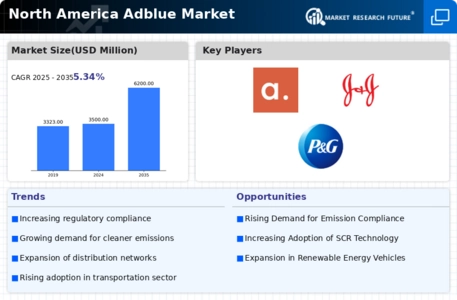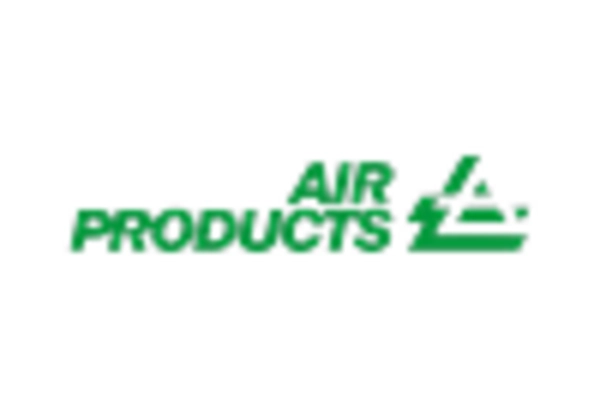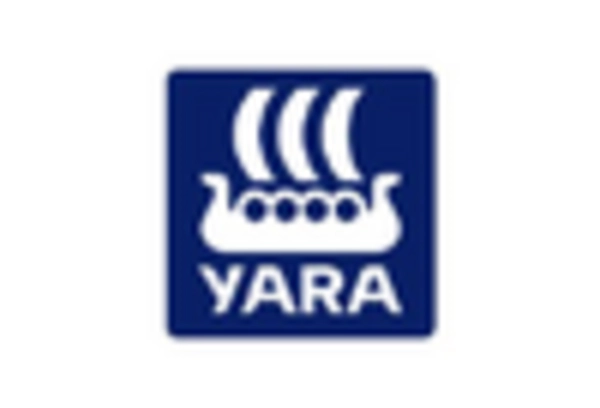Stringent Environmental Regulations
The North America Adblue Market is significantly influenced by stringent environmental regulations aimed at reducing vehicular emissions. Regulatory bodies have implemented various standards that mandate the use of selective catalytic reduction (SCR) systems in diesel engines, which require Adblue for optimal performance. In 2025, it is estimated that compliance with these regulations will drive a 10% increase in Adblue consumption across the region. This regulatory landscape not only compels manufacturers to adopt cleaner technologies but also encourages consumers to choose vehicles equipped with SCR systems. As a result, the North America Adblue Market is poised for growth, as adherence to environmental standards becomes a priority for both manufacturers and consumers alike.
Increasing Demand for Diesel Vehicles
The North America Adblue Market is experiencing a notable surge in demand for diesel vehicles, which are increasingly favored for their fuel efficiency and lower carbon emissions. As more consumers and businesses opt for diesel engines, the necessity for Adblue, a crucial component in reducing nitrogen oxide emissions, becomes more pronounced. In 2025, the market for diesel vehicles is projected to grow by approximately 5% annually, thereby driving the demand for Adblue. This trend is further supported by the automotive sector's shift towards cleaner technologies, which aligns with regulatory requirements. Consequently, the North America Adblue Market is likely to benefit from this growing consumer preference, as manufacturers ramp up production to meet the rising needs of diesel vehicle owners.
Technological Advancements in SCR Systems
The North America Adblue Market is benefiting from rapid technological advancements in selective catalytic reduction (SCR) systems. Innovations in SCR technology have enhanced the efficiency and effectiveness of Adblue usage, leading to improved emissions control in diesel engines. In 2025, the market is expected to witness a 15% increase in the adoption of advanced SCR systems, which utilize Adblue more efficiently. This trend is likely to encourage vehicle manufacturers to integrate these systems into their new models, thereby increasing the overall demand for Adblue. Furthermore, as technology continues to evolve, the North America Adblue Market may see a shift towards more compact and cost-effective SCR solutions, further driving market growth.
Growth of Logistics and Transportation Sector
The North America Adblue Market is closely tied to the growth of the logistics and transportation sector, which relies heavily on diesel-powered vehicles for freight movement. As e-commerce continues to expand, the demand for efficient transportation solutions is on the rise. In 2025, the logistics sector is projected to grow by approximately 6%, leading to an increased need for Adblue in diesel engines. This growth is likely to result in higher consumption of Adblue, as logistics companies seek to comply with environmental regulations while maintaining operational efficiency. Consequently, the North America Adblue Market stands to gain from the burgeoning logistics sector, as more companies invest in cleaner technologies to enhance their sustainability efforts.
Rising Awareness of Environmental Sustainability
The North America Adblue Market is witnessing a shift in consumer attitudes towards environmental sustainability. As awareness of climate change and air quality issues grows, consumers are increasingly seeking vehicles that minimize their environmental impact. This trend is reflected in the rising sales of diesel vehicles equipped with SCR systems that utilize Adblue. In 2025, it is anticipated that consumer demand for environmentally friendly vehicles will contribute to a 12% increase in Adblue consumption. This heightened awareness is prompting manufacturers to prioritize the development of cleaner technologies, thereby fostering growth within the North America Adblue Market. As consumers become more environmentally conscious, the demand for Adblue is likely to continue its upward trajectory.


















Leave a Comment